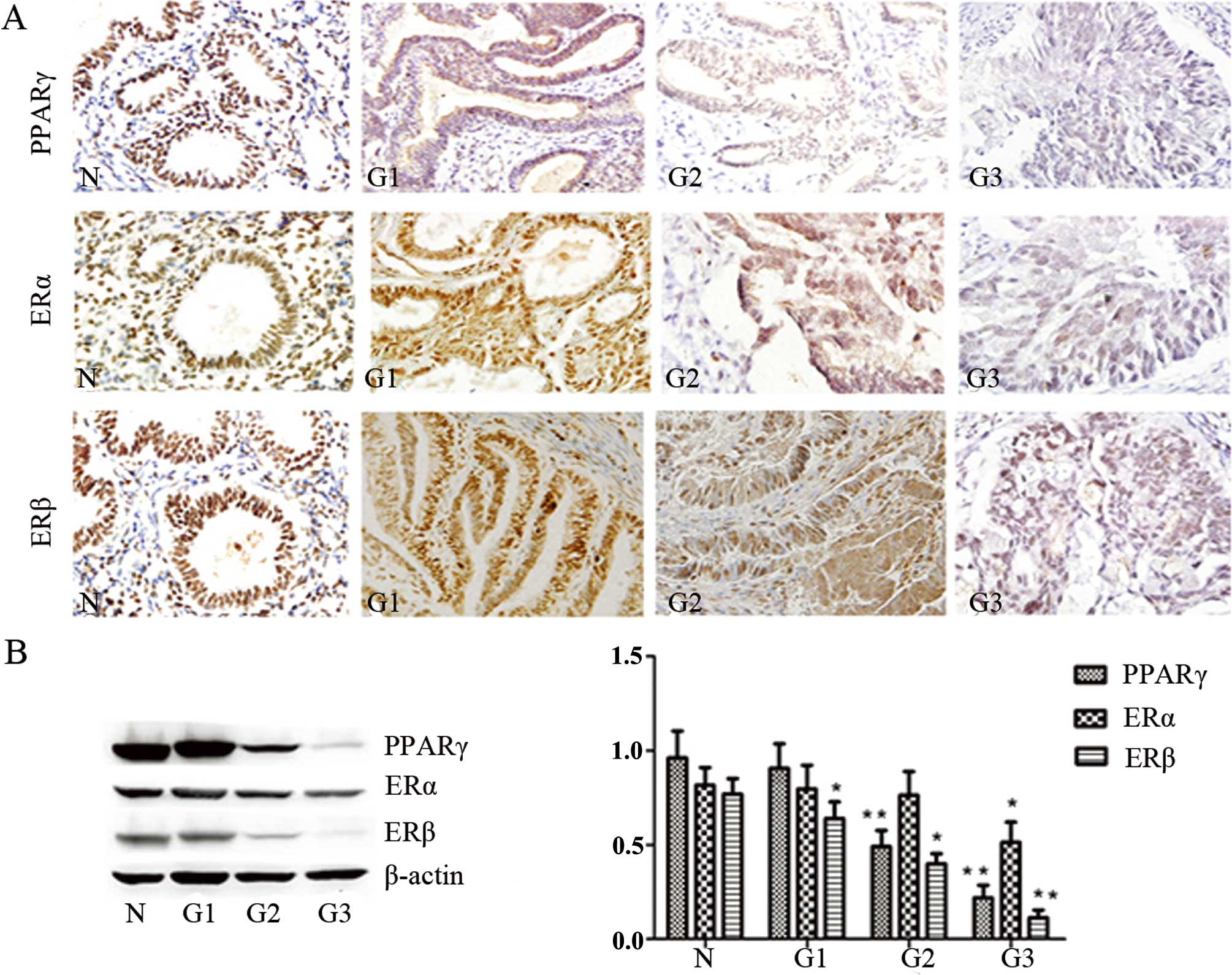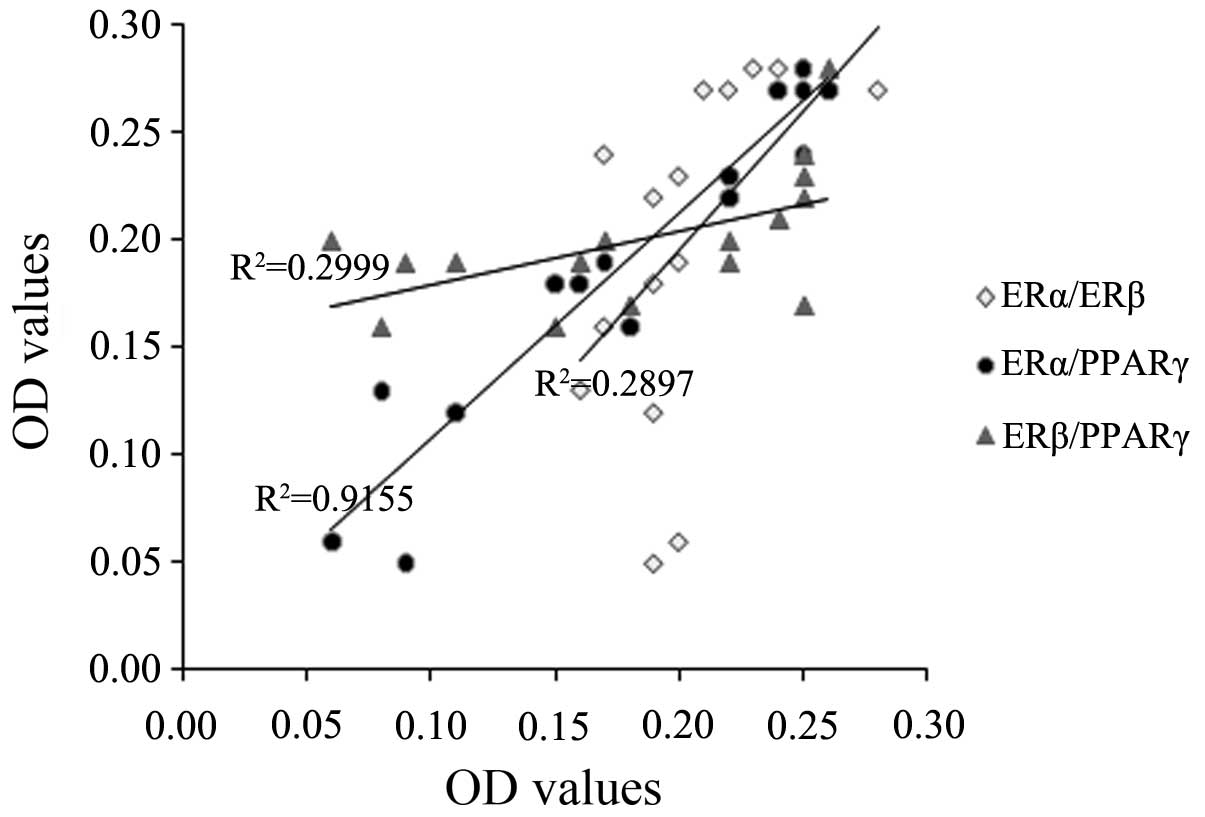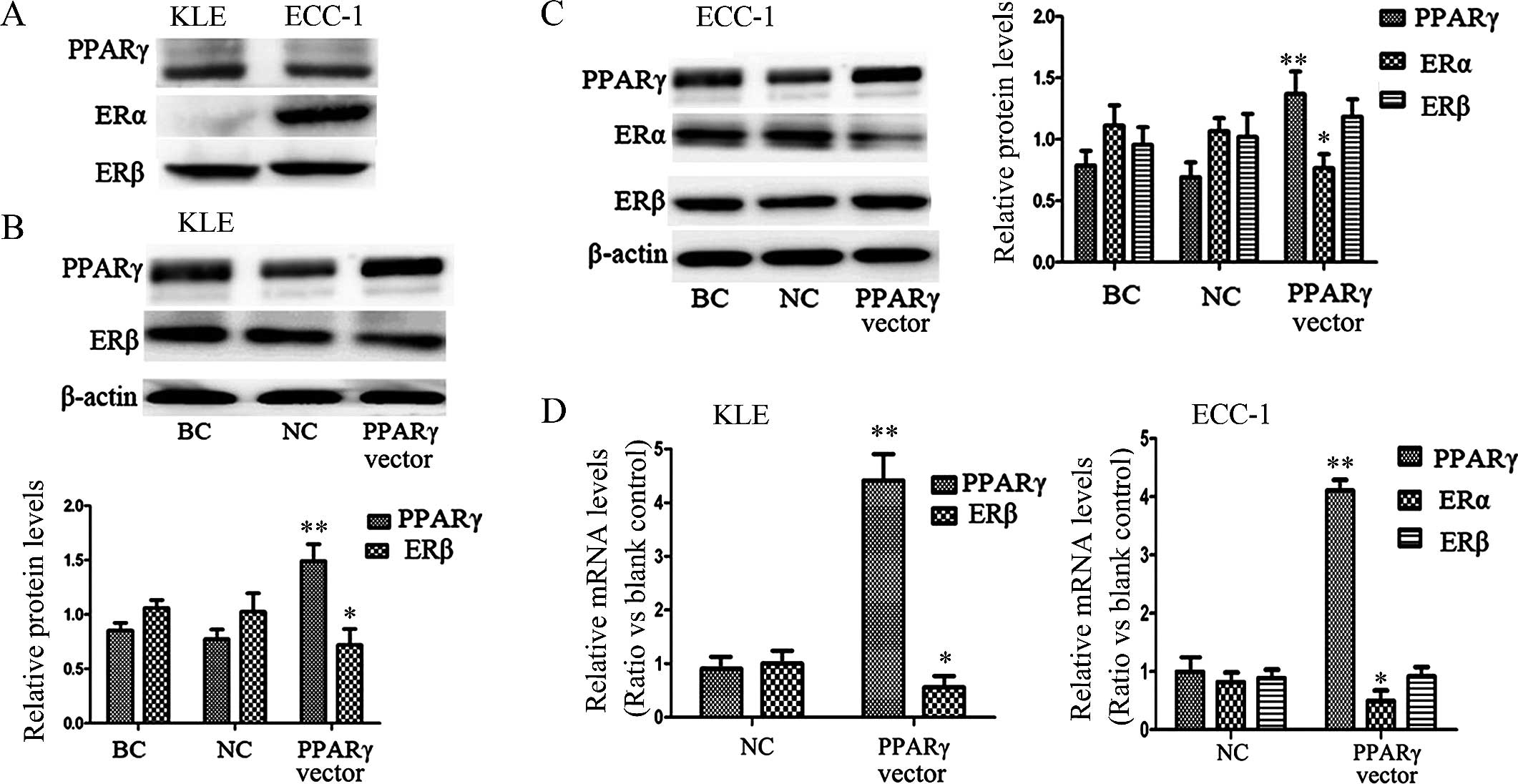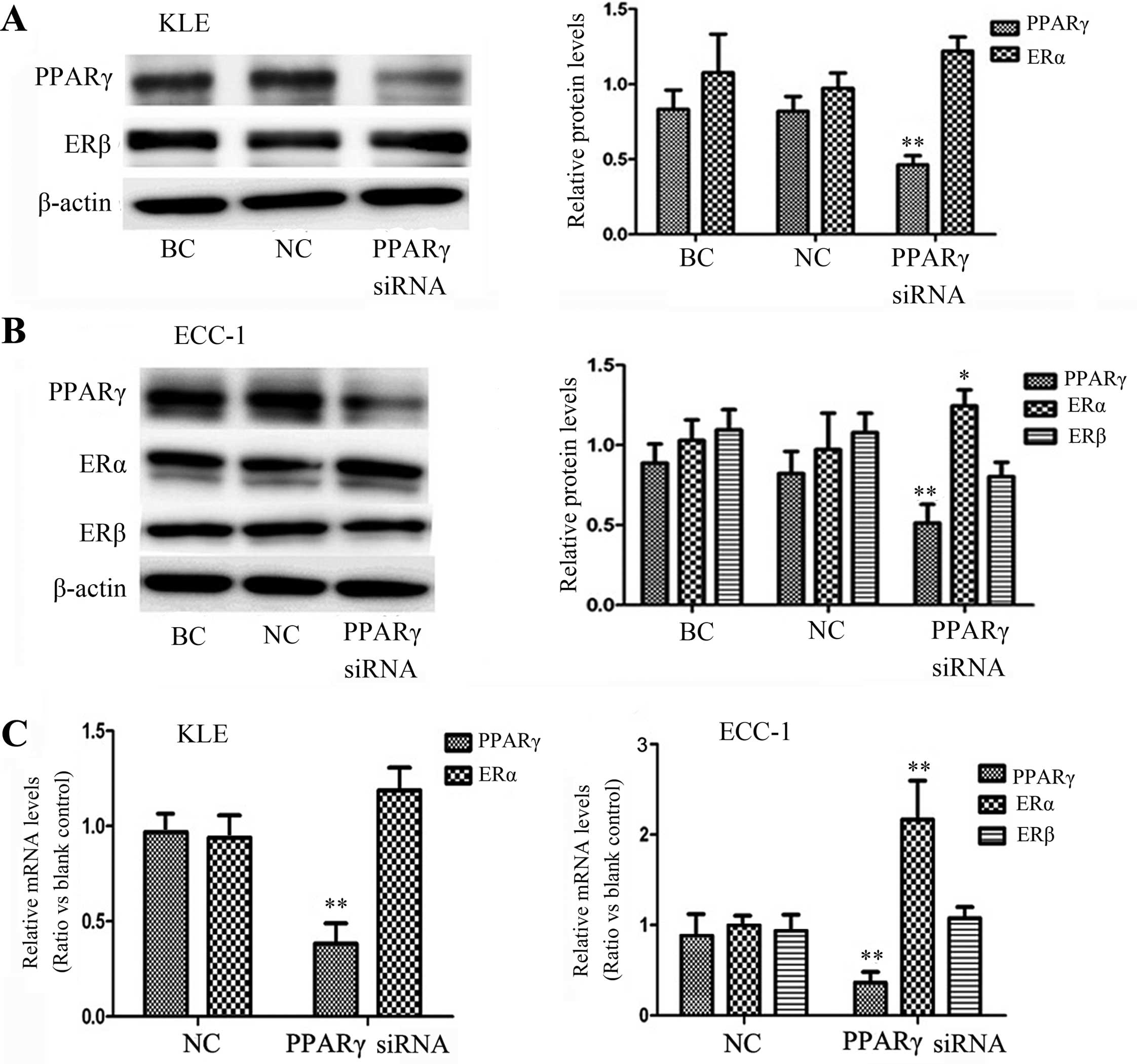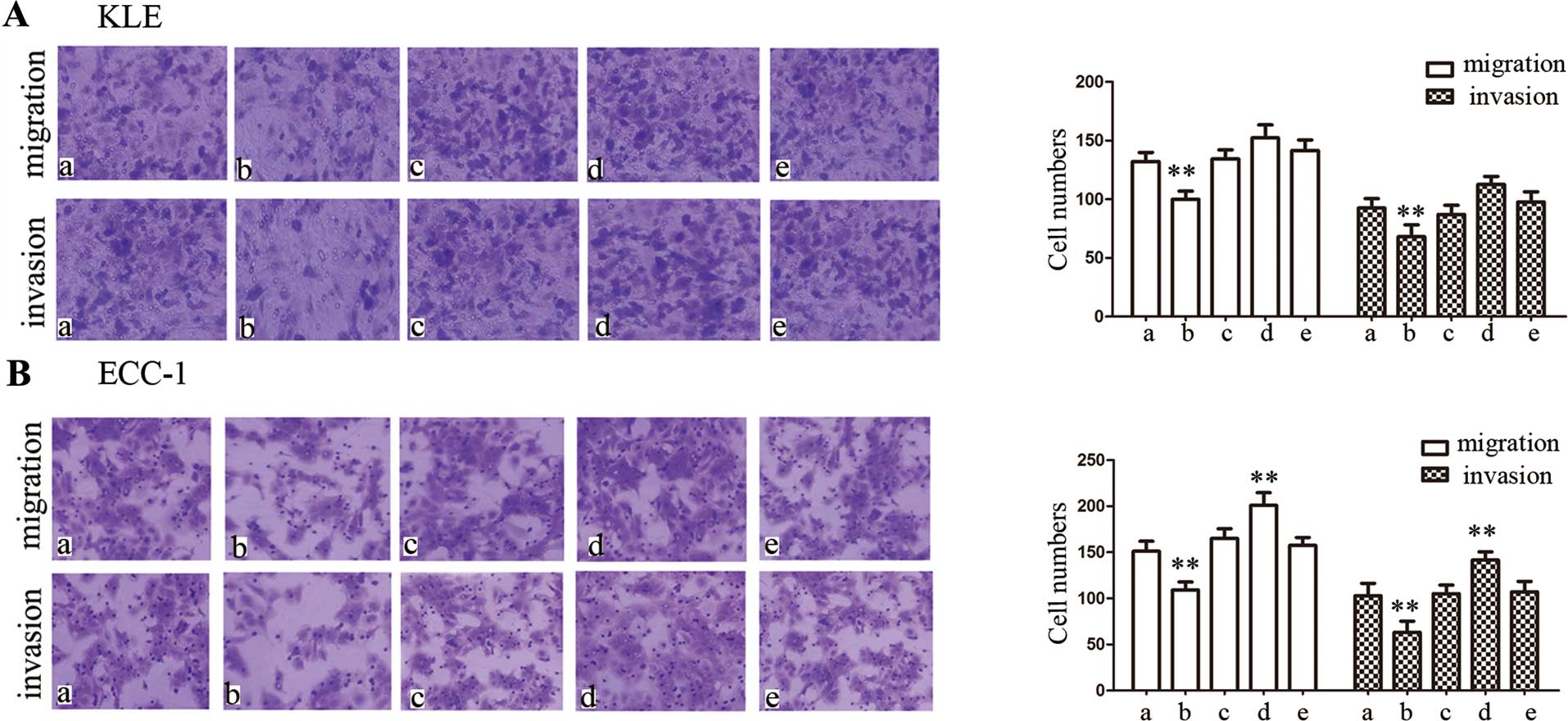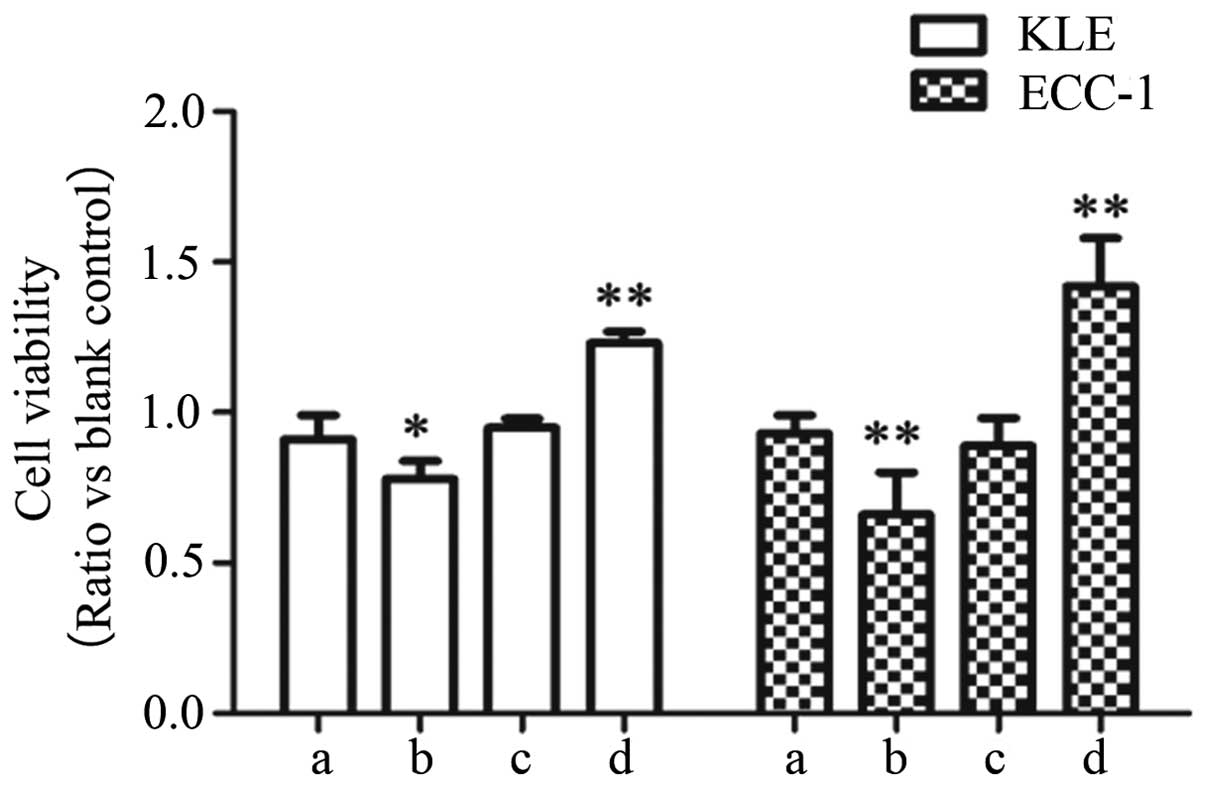Stimulation of peroxisome proliferator-activated receptor γ inhibits estrogen receptor α transcriptional activity in endometrial carcinoma cells
- Authors:
- Published online on: January 15, 2015 https://doi.org/10.3892/or.2015.3729
- Pages: 1227-1234
Abstract
Introduction
Endometrial carcinoma (EC) is one of the most common malignant tumors of the female genital tract and has an increasing incidence worldwide (1). Approximately 70–80% of sporadic endometrial carcinomas are distinguished as type I carcinomas and are associated with endometrial hyperplasia, hyperestrogenism and estrogen receptor (ER) expression. The remaining 20% constitute type II carcinomas, are generally unrelated to estrogen, and exhibit negative or low ER expression (2). Despite a number of studies that have identified prognostic biomarkers for EC, a paucity of reliable markers and therapeutic targets exist to diagnose and treat this disease.
Peroxisome proliferator-activated receptor γ (PPARγ) is a member of the superfamily of nuclear receptors. PPARγ is important in lipid and glucose metabolism, adipose differentiation, inflammatory responses, macrophage differentiation and energy homeostasis (3). In addition, the known risk factors for EC include obesity, type II diabetes mellitus and hypertension (4). Thus, PPARγ ligands, which have been used for the treatment of type II diabetes mellitus, may be important drug candidates for possible endocrine treatment of EC. The expression of PPARγ has been extensively studied in various human carcinomas (5–7), yet little is known concerning PPARγ in EC. Thus, it has become very important to obtain a better understanding of the clinical and biological roles of PPARγ in EC tissues to improve the potential clinical efficiency of PPARγ ligand therapy for endometrial carcinoma patients.
EC is representative of hormone-dependent gynecologic cancers (8). However, attempts to treat female hormone-dependent cancers with anti-hormonal treatments have not been effective, except in early-stage cancers. The ERs are ligand-dependent transcription factors and belong to a superfamily of steroid nuclear receptors (9). To date, two ERs (ERα and ERβ), which are encoded by different genes, have been detected (10). It is well known that the presence of ERα in breast and endometrial carcinoma is associated with a less aggressive phenotype (11,12). However, the roles of ERβ in the development and growth of these tumors have not yet been completely elucidated (13,14). Much of the current interest in understanding the basis of ER actions at the molecular level is focused on the goal of therapeutic intervention (15–17). Despite these efforts, the exact transcriptional effects of ERα and ERβ in EC remain obscure.
Recently, increasing physiologic significance has been attributed to the crosstalk among nuclear receptors, which have been observed at several levels of signal transduction cascades (18–20). PPARγ and ERs belong to a family of nuclear hormone receptors that have been demonstrated to affect the transcriptional activity of each other. An area of relevance to breast cancer is the inhibitory effect of PPARγ on ERα (ER) promoter activation through its interaction with ER response elements (21). PPARγ is expressed in many types of cancer, and it is well established that activation of the receptor inhibits cell proliferation and induces apoptosis (22,23). Therefore, the present study aimed to elucidate the correlation between PPARγ and ER expression in EC and to investigate whether PPARγ activation in endometrial cancer cells contributes to novel approaches for EC therapy.
Materials and methods
Tissue specimens
Samples of 45 endometrial adenocarcinomas and 13 normal endometrium tissues were obtained from surgical pathology specimens at the Department of Gynecology, Qilu Hospital of Shandong University. The samples were immediately frozen in liquid nitrogen and stored at −70°C until analyzed. The specimens were processed for histopathological, immunohistochemical examination and western blot analysis. Information included body mass index (BMI), stage and grade. BMI was calculated by dividing the weight in kilograms by the height in meters squared. We defined obesity as a BMI ≥25 (24). Pathological grading was determined using histopathological analysis and the staging process following the FIGO system. None of these patients received preoperative chemotherapy and/or hormonal therapy or pelvic irradiation. The present study was approved by the Research Ethics Board of Qilu Hospital.
Immunohistochemistry
All specimens were routinely processed (10% formalin-fixed for 24–48 h), paraffin-embedded and thin-sectioned (4 μm). Antigen retrieval was achieved by heating the slides using a microwave at 95°C for 15 min in citric acid buffer (2 mmol/l citric acid, 9 mmol/l trisodium citrate dehydrate, pH 6.0). The dilutions of antibodies used in the present study were as follows: 1:50 for PPARγ (ab19481), 1:50 for ERα (ab37438) and 1:100 for ERβ (ab3576) (all from Abcam, Cambridge, MA, USA). A Histostain®-Plus kit (SP-9000; ZSGB-BIO, Beijing, China) was used to detect the immunostaining of PPARγ, ERα and ERβ. 3,3′-Diaminobenzidine tetrahydrochloride (DAB) was used to visualize the reaction, followed by counterstaining with hematoxylin. For each tissue section, at least three fields were photographed under light microscopy. Two hundred cancer cells in each field were selected, and the labeling index (LI) was determined as the percentage of positive cells/200 cells. Cases with an LI >10% were considered positive EC in the present study.
Cell lines and culture conditions
The endometrial carcinoma cell lines ECC-1 and KLE were purchased from the American Type Culture Collection (ATCC; Manassas, VA, USA). ECC-1 cells were cultured in RPMI-1640 medium with 10% fetal bovine serum (FBS) (Gibco, Carlsbad, CA, USA). KLE cells were cultured in a mixture of Dulbecco’s modified Eagle’s medium (DMEM) and Ham’s F-12 1:1 supplemented with 10% FBS in a 5% CO2 environment at 37°C.
DNA and siRNA transient transfection
The PPARγ expression vector pGST-PPARγ plasmid was a gift of Dr Bert Vogelstin (Johns Hopkins University, Baltimore, MD, USA). Inhibition of PPARγ function was carried out using small interfering RNA synthesized by GenePharma Company (Shanghai, China). The siRNA sequences were as follows: nonsense negative control (5′-CTG CTG ACT TTA CAG AAG AAA CA-3′) and PPARγ siRNA (5′-AAG CCC ATT GAA GAC ATT CAA GA-3′). The cells were grown to 80% confluency in 6-well plates for plasmid DNA transfection. In addition, 4 μg of plasmid DNA was incubated with 8 μl of Lipofectamine 2000 transfection reagent (Invitrogen, Carlsbad, CA, USA) in 0.5 ml of Opti-MEM™ I reduced serum-free medium (Gibco) for 30 min at room temperature, followed by an additional 1.5 ml of serum-free medium. A total of 2 ml of this liposomal complex was then added to cells. To transfect siRNA, the cells were grown to 40% confluency in 6-well plates. In each transfection reaction, 100 pmol of RNA was incubated with 5 μl of Lipofectamine 2000. Cells were then incubated in a 5% CO2 environment at 37°C and then switched to 2 ml of complete medium with 10% FBS after 5 h. Twenty-four hours after transfection, the cells were plated for proliferation, migration and invasion assays. The cells were harvested for RNA and protein analyses at 48 h after transfection.
Quantitative real-time polymerase chain reaction (qRT-PCR)
Total RNA was extracted using TRIzol reagent (Invitrogen) according to the manufacturer’s instructions as previously described (25). RNA concentrations were quantified spectrophotometrically (Thermo Fisher Scientific, Waltham, MA, USA). Then, 1 μg of RNA was reverse transcribed in a total volume of 20 μl using a PrimeScript RT reagent kit according to the manufacturer’s protocol. qRT-PCR was performed using SYBR Premix Ex Taq (both from Takara, Tokyo, Japan) according to the manufacturer’s protocol. The LightCycler system (Roche Diagnostics GmbH, Basle, Switzerland) was used to quantify the mRNA expression levels. The expression of each target gene was normalized to the expression of β-actin. Primers were synthesized by Takara and are listed in Table I.
Western blotting
Tissues were pulverized using a mortar and pestle, with lysis buffer (50 mM Tris-HCl, 150 mM NaCl, 1% Triton X-100, 0.1% sodium deoxycholate, 0.1% SDS and protease inhibitor mixture). The cells were washed twice with ice-cold PBS and then lysed using lysis buffer. After incubation on ice for 20 min, the lysates were cleared by centrifugation for 15 min at 12,000 rpm at 4°C. Protein concentrations were quantified using a BCA protein assay kit (Beyotime Biotechnology, Shanghai, China). Western blotting was performed as previously described (26). Briefly, 30 μg of total protein was separated by SDS-PAGE for 2 h at 80 V and then transferred onto PVDF membranes (Millipore, Billerica, MA, USA) for 1.5 h at 200 mA. The membranes were blocked for 2 h at room temperature in 5% non-fat dry milk. The primary antibody was incubated overnight at 4°C, and the secondary antibody was incubated for 1 h at room temperature. Protein expression was detected using ECL (Millipore), and the mean intensity of the bands was quantified using ImageJ (version 1.45). β-actin was also evaluated as an internal control. The dilutions of the primary antibodies used In the present study were as follows: 1:500 for PPARγ (#2453; Cell Signaling Technology, Danvers, MA, USA), 1:100 for ERα (ab37438), 1:1,000 for ERβ (ab3576) (both from Abcam, Cambridge, MA, USA) and 1:3,000 for β-actin (AP0060; Bioworld, Minneapolis, MN, USA). The dilution of the secondary goat anti-rabbit IgG-HRP antibody (BS10350; Bioworld) was 1:20,000.
In vitro migration and invasion assays
For the Transwell migration assays, 1×105 cells were plated in the top chamber with a non-coated membrane (24-well insert; 8-μm pore size; Corning Costar, Tewksbury, MA, USA). For the invasion assays, 2×105 cells were plated in the top chamber with a Matrigel-coated membrane (BD Biosciences, San Jose, CA, USA). In both assays, the cells were plated in medium without serum, and medium supplemented with 10% serum was used as a chemoattractant in the lower chamber. Following incubation for 24 h, the cells that did not migrate or invade through the pores were removed by a cotton swab. Cells on the underside of the membrane were fixed with methanol, stained by 0.1% crystal violet, and photographed at ×200 magnification. The cells numbers were counted in five randomly selected fields.
Cell proliferation assay
Cell proliferation was determined using the Cell Counting Kit-8 (Beyotime) according to the manufacturer’s instructions. Briefly, 24 h after transfection, the cells were plated for the proliferation assays, with 5×103 cells/well seeded in a 96-well plate and grown at 37°C for 24 h. After 10 μl of WST-8 dye was added to each well, the cells were incubated at 37°C for 2 h, and the absorbance was finally determined at 450 nm using a microplate reader (Thermo Fisher Scientific).
Statistical analysis
All results, including transfection, were repeated using independent experiments in triplicate. The χ2 test was used to analyze the distribution of cases considered positive for the biological parameters. The correlation between the expressions was analyzed by the Pearson correlation. Statistical analysis between small groups of subjects was performed using the non-parametric Mann-Whiney U test. Statistical significance was assumed at P<0.05. All calculations were performed using SPSS 17.0 software.
Results
Expression of PPARγ, ERα and ERβ in normal endometrium and endometrial carcinomas
PPARγ, ERα and ERβ immunoreactivity were identified in the cell nuclei. PPARγ immunoreactivity was significantly lower in the EC tissues than that in the normal endometrium (P<0.05). The statistical analysis indicated a significant correlation between PPARγ expression and the clinicopathological variables (P<0.05). The expression of ERα was gradually reduced in the moderately and poorly differentiated endometrial carcinoma (P<0.05). The expression of ERβ was only decreased in the poorly differentiated endometrial carcinoma, and no significant associations were detected between ERβ and the clinicopathological variables (Fig. 1, Table II). Furthermore, we found a positive linear variation for PPARγ and ERα immune expression (P<0.05) and no correlations between the expression of ERα and ERβ, or ERβ and PPARγ (Fig. 2). The decreased expression of PPARγ and ERα in the endometrial carcinomas suggest that aberrant PPARγ and ERα expression may be an early molecular event in cancer development.
Table IICorrelation between PPARγ, ERα, ERβ expression immunoreactivity and clinical parameters in EC. |
Stimulation of PPARγ downregulates expression of the ERs in endometrial carcinoma cell lines
The PPARγ immunoreactivity results demonstrated a strong association between PPARγ and ERα in EC (P<0.05), suggesting a possible interaction of these two nuclear receptors in human EC cells. Thus, we used two EC cell lines in the following experiments in vitro. The expression of ERs in each cell line was evaluated using western blotting. Only ERβ was expressed in the KLE cells, whereas ERα and ERβ were expressed in the ECC-1 cells, and PPARγ was expressed in both cell lines (Fig. 3A).
When KLE cells were transfected with the expression vector pGST-PPARγ for 48 h, the expression of PPARγ protein increased 49.04%, and the expression of ERβ decreased 28.15% significantly (P<0.01), when compared with the negative control cells (Fig. 3B). In the transfected ECC-1 cells under the same conditions, we found increased expression of PPARγ protein of 36.96% and decreased expression of ERα of 23.41% (P<0.01); however, we did not observe the noticeable depression of ERβ protein in this cell line (Fig. 3C). According to previous studies, PPARγ inhibits ER transcriptional activity through its interaction with ER response elements (ERE) (27,28). To provide further insight into the effects of PPARγ on the activity of ERs, we investigated mRNA levels using qRT-PCR. As expected, the downstream ER activity was confirmed as a decrease in ER gene expression after transfection with the PPARγ expression vector (Fig. 3D). As shown by qRT-PCR and western blot analysis, stimulation of PPARγ did not significantly inhibit transactivation of ERβ in the ECC-1 cells, indicating that in the ECC-1 cell line, the PPARγ effect occurred predominantly through ERα.
Inhibition of PPARγ upregulates ERα expression in the endometrial carcinoma cell lne ECC-1
To obtain a better understanding of whether suppression of PPARγ expression is associated with ER expression, we transfected PPARγ siRNA and then analyzed both the protein and mRNA levels of ERs. As shown in Fig. 4A and B, after PPARγ siRNA transfection, the PPARγ protein levels in the KLE and ECC-1 cells were decreased by 53.64 and 48.71%, respectively. We also noted increased ERα expression in the ECC-1 cell line, yet not ERβ, in both cell lines. The mRNA levels were confirmed by qRT-PCR analysis (Fig. 4C). These data demonstrate a negative crosstalk between the PPARγ and ER signaling pathways (P<0.05). ECC-1 expressed both the ERα and ERβ receptors, and KLE only expressed the ERβ receptor. Although we did not evaluate whether or not PPARγ regulated ER expression via ERα only, ERα may be more closely related with the mechanism than ERβ.
Stimulation of PPARγ inhibits the migratory and invasive abilities of endometrial carcinoma cell lines
Having analyzed the interactions of protein and gene expression between PPARγ and ERs, we next evaluated the biological effects of upregulating or downregulating the PPARγ expression in EC cells. In the present study, we investigated cell migration and invasion using Transwell migration and invasion assays. After 24 h of transfection with the PPARγ expression vector, the migratory or invasive cell numbers were significantly decreased compared with the controls in both cell lines (P<0.01) (Fig. 5). However, after 24 h of transfection with PPARγ siRNA in KLE cells, there were no differences in migration or invasive cell numbers compared with the controls (Fig. 5A). On the contrary, downregulation of PPARγ expression enhanced the migratory and invasive abilities in the ECC-1 cells (P<0.01) (Fig 5B).
Enhanced PPARγ expression inhibits cell proliferation in endometrial carcinoma cell lines
The stimulation of PPARγ has demonstrated growth inhibitory effects on different tumor cell types, including colon (5), lung (6) and breast cancer (7). Therefore, PPARγ has been considered as a molecular target for cancer chemoprevention (29). Thus, we would expect that PPARγ activation results in decreased cell proliferation in endometrial carcinoma cells. Here, to investigate whether the aberrant expression of PPARγ influences EC cell viability, we performed a CCK-8 assay in each cell line. As expected, the number of KLE and ECC-1 cells was significantly decreased after transfection with the PPARγ expression vector (P<0.05) (Fig. 6). Moreover, our data revealed that the proliferation of the two cell lines was significantly promoted after transfection with PPARγ siRNA (P<0.05) (Fig. 6).
Discussion
Although PPARγ was first isolated in 1990 by Issemann and Green (30), its function has not yet been clearly elucidated. Our finding of a decreased level of PPARγ in endometrial carcinoma is consistent with previous observations (24,29) and provides strong evidence supporting the biological significance and clinical relevance in EC (Fig. 1, Table II). Our data also demonstrated that the expression levels of ERα decreased with the degree of differentiation and the stage of the tumor, with significant correlation in this respect (P<0.05), whereas the expression of ERβ was only decreased in poorly differentiated EC, and no significant associations were detected between ERβ and the clinicopathological variables. Other studies have disputed the importance of ERα and ERβ expression and have failed to demonstrate direct correlations with the tumor grade or the stage of the differentiation. Saegusa and Okayasu examined ERα and ERβ expression in normal and malignant endometrium and found a stepwise decrease in ERβ with increasing grade, whereas ERβ levels remained unchanged. They concluded that ERα expression and a shift in the ratio of the two subtypes play an important role during endometrial tumorigenesis (31). However, among the few published reports that investigated ERβ expression in EC, the decreased expression of ERβ was observed in EC compared with normal endometrium, and there was a significant association with tumor clinicopathological variables. Thus, they indicated that ERβ alterations may be more important in EC (32). Therefore, it would be of value to reexamine the expression levels of ERα and ERβ in human EC tissues using a larger sample size.
In the present study, we also demonstrated that ERα expression was regulated by PPARγ, and the evidence was obtained with an ERα-positive EC cell line (ECC-1). To date, studies on the crosstalk of ER and PPARγ in target tissues have mostly been concerned with breast cancer, and little is known about their involvement in EC. Our data confirmed that stimulating PPARγ expression suppressed ERα expression both at the mRNA and protein levels in ECC-1 cells, yet no noticeable suppression of ERβ was detected. In addition, after inhibiting the expression of PPARγ in ECC-1 cells, we found that ERα was significantly increased but not ERβ. For PPARγ, the heterodimers formed with RXR are able to bind to diverse hormone responsive elements such as ERE (27,28), and negatively interfere with ER transcription. Although the exact mechanism remains to be clarified, our investigation indicated that the molecular mechanism occurred predominantly through ERα in EC.
Recent studies have mainly focused on the physical association between the crosstalk of ERα and PPARγ, and until now, there have been few reports on the biological effects on endometrial carcinoma cells after upregulating or downregulating PPARγ expression. On the basis of our findings, PPARγ activation inhibited the migratory and invasive abilities and the growth of EC cells, and ECC-1 cells were more sensitive to this inhibition. In our investigation into the effects of downregulating PPARγ expression, we found enhanced migratory and invasive abilities in the ECC-1 but not in the KLE cell line. These findings indicate that in EC cells, the PPARγ effect occurred predominantly through ERα. Previous studies have reported the ability to inhibit growth and differentiation induced by PPARγ activation, and nuclear expression of PPARγ has been reported to be associated with a lower risk of recurrence of female breast cancer (33). Therefore, PPARγ has been considered an important molecular target for cancer chemoprevention. Notably, the effects of PPARγ activation on EC are largely unknown, and our investigation may open a new direction for the development of novel therapeutic methods targeting PPARγ in endometrial carcinoma treatment, particularly ERα-positive carcinomas.
Taken together, our results indicate that PPARγ and ERα play a role in the onset and progression of EC. It is likely that the activation of PPARγ mediates ER transactivation mainly through ERα. Therefore, PPARγ activation may potentiate anti-estrogen therapy in ERα-positive endometrial carcinoma. Further research needs to investigate whether targeting PPARγ has potential as a clinical treatment for ERα-positive endometrial tumors.
Acknowledgements
We thank Dr Bert Vogelstin (John Hopkins University, USA) for providing the PPARγ expression vector pGST-PPARγ plasmid. The present study was supported by the Natural Scientific Foundation of Shandong Province (ZR2010HM102).
References
|
Boll D, Karim-Kos HE, Verhoeven RH, et al: Increased incidence and improved survival in endometrioid endometrial cancer diagnosed since 1989 in The Netherlands: a population based study. Eur J Obstet Gynecol Reprod Biol. 166:209–214. 2013. View Article : Google Scholar | |
|
Gadducci A, Cosio S and Genazzani AR: Old and new perspectives in the pharmacological treatment of advanced or recurrent endometrial cancer: hormonal therapy, chemotherapy and molecularly targeted therapies. Crit Rev Oncol Hematol. 58:242–256. 2006. View Article : Google Scholar : PubMed/NCBI | |
|
Tavares V, Hirata MH and Hirata RD: Peroxisome proliferator-activated receptor γ (PPAR γ): molecular study in glucose homeostasis, lipid metabolism and therapeutic approach. Arq Bras Endocrinol Metabol. 51:526–533. 2007. View Article : Google Scholar : PubMed/NCBI | |
|
Berstein LM, Kvatchevskaya JO, Poroshina TE, Kovalenko IG, et al: Insulin resistance, its consequences for the clinical course of the disease, and possibilities of correction in endometrial cancer. J Cancer Res Clin Oncol. 130:687–693. 2004. View Article : Google Scholar : PubMed/NCBI | |
|
Tsukahara T and Haniu H: Peroxisome proliferator-activated receptor gamma overexpression suppresses proliferation of human colon cancer cells. Biochem Biophys Res Commun. 424:524–529. 2012. View Article : Google Scholar : PubMed/NCBI | |
|
Reka AK, Goswami MT, Krishnapuram R, Standiford TJ and Keshamouni VG: Molecular cross-regulation between PPAR-γ and other signaling pathways: implications for lung cancer therapy. Lung Cancer. 72:154–159. 2011. View Article : Google Scholar : PubMed/NCBI | |
|
Jiang Y, Huang Y, Cheng C, et al: Combination of thiazolidinedione and hydralazine suppresses proliferation and induces apoptosis by PPARγ up-expression in MDA-MB-231 cells. Exp Mol Pathol. 91:768–774. 2011. View Article : Google Scholar : PubMed/NCBI | |
|
Ito K, Utsunomiya H, Niikura H, Yaegashi N and Sasano H: Inhibition of estrogen actions in human gynecological malignancies: new aspects of endocrine therapy for endometrial cancer and ovarian cancer. Mol Cell Endocrinol. 340:161–167. 2011. View Article : Google Scholar | |
|
Shabani N, Kuhn C, Kunze S, et al: Prognostic significance of oestrogen receptor alpha (ERα) and beta (ERβ), progesterone receptor A (PR-A) and B (PR-B) in endometrial carcinomas. Eur J Cancer. 43:2434–2444. 2007. View Article : Google Scholar : PubMed/NCBI | |
|
Ito K, Utsunomiya H, Yaegashi N and Sasano H: Biological roles of estrogen and progesterone in human endometrial carcinoma - new developments in potential endocrine therapy for endometrial cancer. Endocr J. 54:667–679. 2007. View Article : Google Scholar : PubMed/NCBI | |
|
Pearce ST and Jordan VC: The biological role of estrogen receptors α and β in cancer. Crit Rev Oncol Hematol. 50:3–22. 2004. View Article : Google Scholar : PubMed/NCBI | |
|
Kurebayashi J, Otsuki T, Kunisue H, Tanaka K, Yamamoto S and Sonoo H: Expression levels of estrogen receptor-α, estrogen receptor-β, coactivators, and corepressors in breast cancer. Clin Cancer Res. 6:512–518. 2000.PubMed/NCBI | |
|
Mann S, Laucirica R, Carlson N, et al: Estrogen receptor beta expression in invasive breast cancer. Hum Pathol. 32:113–118. 2001. View Article : Google Scholar : PubMed/NCBI | |
|
Lin CY, Ström A, Li Kong S, et al: Inhibitory effects of estrogen receptor beta on specific hormone-responsive gene expression and association with disease outcome in primary breast cancer. Breast Cancer Res. 9:R252007. View Article : Google Scholar : PubMed/NCBI | |
|
Jensen EV and Jordan VC: The estrogen receptor: a model for molecular medicine. Clin Cancer Res. 9:1980–1989. 2003.PubMed/NCBI | |
|
Yuan H, Kopelovich L, Yin Y, Lu J and Glazer RI: Drug-targeted inhibition of peroxisome proliferator-activated receptor-gamma enhances the chemopreventive effect of anti-estrogen therapy. Oncotarget. 3:345–356. 2012.PubMed/NCBI | |
|
Tateishi Y, Kawabe Y, Chiba T, et al: Ligand-dependent switching of ubiquitin-proteasome pathways for estrogen receptor. EMBO J. 23:4813–4823. 2004. View Article : Google Scholar : PubMed/NCBI | |
|
Kato S: Estrogen receptor-mediated cross-talk with growth factor signaling pathways. Breast Cancer. 8:3–9. 2001. View Article : Google Scholar : PubMed/NCBI | |
|
Zhang Z, Zhou D, Lai Y, et al: Estrogen induces endometrial cancer cell proliferation and invasion by regulating the fat mass and obesity-associated gene via PI3K/AKT and MAPK signaling pathways. Cancer Lett. 319:89–97. 2012. View Article : Google Scholar : PubMed/NCBI | |
|
Glass CK, Holloway JM, Devary OV and Rosenfeld MG: The thyroid hormone receptor binds with opposite transcriptional effects to a common sequence motif in thyroid hormone and estrogen response elements. Cell. 54:313–323. 1988. View Article : Google Scholar : PubMed/NCBI | |
|
Wang X and Kilgore MW: Signal cross-talk between estrogen receptor alpha and beta and the peroxisome proliferator-activated receptor gamma1 in MDA-MB-231 and MCF-7 breast cancer cells. Mol Cell Endocrinol. 194:123–133. 2002. View Article : Google Scholar : PubMed/NCBI | |
|
Nickkho-Amiry M, McVey R and Holland C: Peroxisome proliferator-activated receptors modulate proliferation and angiogenesis in human endometrial carcinoma. Mol Cancer Res. 10:441–453. 2012. View Article : Google Scholar | |
|
Mansure JJ, Nassim R and Kassouf W: Peroxisome proliferator-activated receptor γ in bladder cancer: a promising therapeutic target. Cancer Biol Ther. 8:6–15. 2009. View Article : Google Scholar : PubMed/NCBI | |
|
Ota K, Ito K, Suzuki T, et al: Peroxisome proliferator-activated receptor γ and growth inhibition by its ligands in uterine endometrial carcinoma. Clin Cancer Res. 12:4200–4208. 2006. View Article : Google Scholar : PubMed/NCBI | |
|
Brody F, Hill S, Celenski S, et al: Expression of ectonucleotide pyrophosphate phosphodiesterase and peroxisome proliferator activated receptor γ in morbidly obese patients. Surg Endosc. 21:941–944. 2007. View Article : Google Scholar : PubMed/NCBI | |
|
Houston KD, Copland JA, Broaddus RR, Gottardis MM, Fischer SM and Walker CL: Inhibition of proliferation and estrogen receptor signaling by peroxisome proliferator-activated receptor γ ligands in uterine leiomyoma. Cancer Res. 63:1221–1227. 2003.PubMed/NCBI | |
|
Keller H, Givel F, Perroud M and Wahli W: Signaling cross-talk between peroxisome proliferator-activated receptor/retinoid X receptor and estrogen receptor through estrogen response elements. Mol Endocrinol. 9:794–804. 1995.PubMed/NCBI | |
|
Kliewer SA, Umesono K, Noonan DJ, Heyman RA and Evans RM: Convergence of 9-cis retinoic acid and peroxisome proliferator signalling pathways through heterodimer formation of their receptors. Nature. 358:771–774. 1992. View Article : Google Scholar : PubMed/NCBI | |
|
Knapp P, Chabowski A, Blachnio-Zabielska A, Jarzabek K and Wołczyński S: Altered peroxisome-proliferator activated receptors expression in human endometrial cancer. PPAR Res. 2012:4715242012. View Article : Google Scholar : PubMed/NCBI | |
|
Issemann I and Green S: Activation of a member of the steroid hormone receptor superfamily by peroxisome proliferators. Nature. 347:645–650. 1990. View Article : Google Scholar : PubMed/NCBI | |
|
Saegusa M and Okayasu I: Changes in expression of estrogen receptors alpha and beta in relation to progesterone receptor and pS2 status in normal and malignant endometrium. Jpn J Cancer Res. 91:510–518. 2000. View Article : Google Scholar : PubMed/NCBI | |
|
Chakravarty D, Srinivasan R, Ghosh S, Rajwanshi A and Gopalan S: Estrogen receptor beta (ERbeta) in endometrial simple hyperplasia and endometrioid carcinoma. Appl Immunohistochem Mol Morphol. 16:535–542. 2008. View Article : Google Scholar : PubMed/NCBI | |
|
Jiang Y, Zou L, Zhang C, et al: PPARγ and Wnt/β-catenin pathway in human breast cancer: expression pattern, molecular interaction and clinical/prognostic correlations. J Cancer Res Clin Oncol. 135:1551–1559. 2009. View Article : Google Scholar : PubMed/NCBI |



